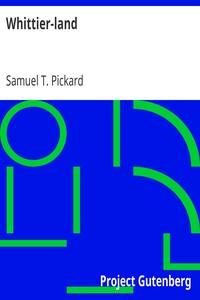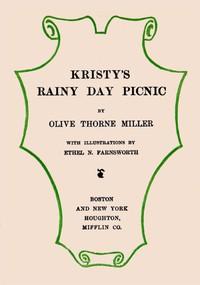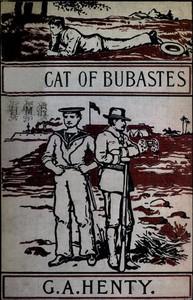|
|
Read this ebook for free! No credit card needed, absolutely nothing to pay.Words: 35927 in 18 pages
This is an ebook sharing website. You can read the uploaded ebooks for free here. No credit cards needed, nothing to pay. If you want to own a digital copy of the ebook, or want to read offline with your favorite ebook-reader, then you can choose to buy and download the ebook.

: Whittier-land A Handbook of North Essex Containing Many Anecdotes of and Poems by John Greenleaf Whittier Never Before Collected. by Pickard Samuel T Samuel Thomas - Whittier John Greenleaf 1807-1892 Homes and haunts Massachusetts Essex County; Literary l@FreeBooksWed 07 Jun, 2023 d in 1739 by Hugh Tallant, in front of the Saltonstall mansion. This mansion is now occupied by the Haverhill Historical Society, and most of the famous row of "Occidental plane-trees" were cut down many years ago, a sacrifice to street improvement. Three of the ancient trees still stand, and will probably round out the second century of their existence. They are about eighty feet in height, and measure nearly twenty feet around their trunks. Under these trees Washington "drew rein," and Whittier repeats the legend that he said:-- "I have seen no prospect fairer In this goodly Eastern land." About a mile below on the northeasterly side of Millvale, a hill picturesquely crowned with pines attracts attention. This is the Ramoth Hill immortalized in the lovely poem "My Playmate:"-- "The pines were dark on Ramoth Hill, Their song was soft and low. . . . . . "And still the pines of Ramoth wood Are moaning like the sea,-- The moaning of the sea of change Between myself and thee!" Until recently there has been much doubt as to the location of Ramoth Hill, Whittier himself giving no definite answer when asked in regard to it. Indeed, the poem as originally written had the title "Eleanor," and the hill was given the name of Menahga. But Mr. J. T. Fields, to whom the manuscript was submitted, did not like this name, and Whittier changed it to Ramoth, which suited his editor's taste. Mr. Alfred A. Ordway, the best authority on all matters pertaining to Whittier's allusions to places in this region, has discovered that the name Menahga was given to this particular hill in Haverhill by Mrs. Mary S. West of Elmwood, one of a family all the members of which were dear to Whittier from his boyhood to the close of his life. A letter of Whittier's to Mrs. West has come to light, written about the time this poem was composed, in which he commends the selection of the name of this hill, and intimates that he shall use it in a poem. On the Country Bridge road, leading from the birthplace to Rocks Village, is an ancient edifice, known as the "Old Garrison House," which is of interest to Whittier-Land pilgrims because it was the home of Whittier's great-grandmother, Mary Peaslee, who brought Quakerism into the Whittier family. Thomas Whittier, the pioneer, did not belong to the Society of Friends, though favorably disposed toward the sect. His youngest son, Joseph, brought the young Quakeress into the family, and their descendants for several generations, down to the time of the poet, belonged to the sect founded by her father's friend, George Fox. Joseph Peaslee built this house with bricks brought from England before 1675. As it was one of the largest and strongest houses in the town, in the time of King Philip's war it was set apart by the town authorities as a house of refuge for the families of the neighborhood, and as a rallying point for the troops kept on the scout. There are many port-holes through its thick walls. A little farther on we come to Rocks Village, pictured so perfectly by Whittier in his poem "The Countess," that it will be at once recognized:-- "Over the wooded northern ridge, Between its houses brown, To the dark tunnel of the bridge The street comes straggling down." The bridge across the Merrimac at this point was a covered and gloomy structure at the time this poem was written. It has since been partially remodeled, and many of the houses of the "stranded village," then brown and paintless, have received modern improvements. But there is enough of antiquity still clinging to the place to make it recognizable from Whittier's lines. This was the market to which the Whittiers brought much of the produce of their farm to barter for household supplies. This was the home of Dr. Elias Weld, the "wise old doctor" of "Snow-Bound," and it was to him "The Countess" was inscribed--the poem which every year brings many visitors hither, for the grave of the Countess is near. Whittier was still in his teens when this eccentric physician left Rocks Village and removed to Hallowell, Maine, and almost half a century had intervened before he wrote that remarkable tribute to the friend and benefactor of his youth, which is found in the prelude to "The Countess." The good old man died at Hudson, Ohio, a few months after the publication of the lines that meant so much to his fame, and it is pleasant to know that they consoled the last hours of his long life. Whittier did not know whether or not the benefactor of his boyhood was living in 1863, when he wrote the poem, as is shown in the lines:-- Free books android app tbrJar TBR JAR Read Free books online gutenberg More posts by @FreeBooks
: The Lonely Way—Intermezzo—Countess Mizzie Three Plays by Schnitzler Arthur Bj Rkman Edwin Translator - German drama Translations into English@FreeBooksWed 07 Jun, 2023

: Kristy's Rainy Day Picnic by Miller Olive Thorne Farnsworth Ethel N Illustrator - Children's stories; Storytelling Fiction@FreeBooksWed 07 Jun, 2023
|
Terms of Use Stock Market News! © gutenberg.org.in2025 All Rights reserved.






